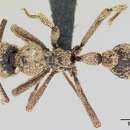en
names in breadcrumbs


This and other basicerotines are renowned for their camouflage and cryptic behavior (Hoelldobler and Wilson 1986, Wilson and Brown 1985). Foraging workers of B. manni are usually covered with a tightly-adhering layer of soil. Their bodies are covered with two kinds of specialized setae: longer erect "brush hairs" and shorter, appressed to suberect "holding hairs." Hoelldobler and Wilson speculated that the brush hairs act to gather soil particles from the environment, and the holding hairs act to adhere the soil to the body.
Wilson and Hoelldobler (1986) carried out the most extensive behavioral observations of this species. They collected three colonies at La Selva Biological Station, and observed them in the laboratory for a month. I repeat here the abstract of their report:
We report here the first detailed observations of a member of the Neotropical genus Basiceros (B. manni), which possesses the largest and anatomically most primitive workers and queens within the ant tribe Basicerotini.
1. Colonies of Basiceros manni were found nesting in small rotting logs and a leguminous seed pod on the floor of Costa Rican rain forest. The mature colony composition is a single dealate queen and approximately 50 workers. New queens and males eclosed during late March, in the dry season.
2. B. manni workers and queens are cryptically colored to an extreme degree, a condition enhanced by the accumulation of soil and litter particles on the body surface with the aid of a double layer of plumose hairs. They are also among the slowest-moving of all ants and "freeze" into immobility for minutes at a time when disturbed.
3. The workers capture a wide diversity of insects, including beetle larvae and (in the laboratory) centipedes, termites, and Drosophila adults. The prey are fed directly to the larvae. So far as known the workers forage singly and do not recruit.
4. Emigration is facilitated by a communication behavior apparently preliminary to adult transport: workers that have encountered suitable nest sites tug at the appendages of nestmates, causing them to search on their own. Workers also carry nestmates to the new sites, but less commonly.
5. The repertory size is unusually small for myrmicine ants. A relatively simple temporal division of labor occurs, with young workers functioning more as nurses and older ones as foragers. The ovaries are maximally developed in the youngest workers, evidently in association with the laying of trophic eggs. Conversely, the poison gland reservoir reaches its greatest size in older workers, in association with increased predatory activity.
6. Overall, B. manni has a behavioral repertory comparable in complexity but not in detail to that of Eurhopalothrix heliscata, the only other basicerotine species studied to date.
I have encountered this species in lowland wet forest sites throughout Costa Rica, usually as nocturnal strays on the ground, or as occasional workers in Winkler samples.
I observed a nest in the Los Patos area of Corcovado National Park, a primary rainforest site. The nest was in a bit of very rotten wood at the base of a small tree. I was able to collect 20 workers, 3 pupae, and numerous larvae. The workers were scattered in several chambers. One chamber had most of the brood and all of the pupae. Another chamber had a few larvae and 4 empty gastropod shells. The gastropods were of the same species, with a long pointed spiral.
Ted Schultz collected a nest in primary rainforest at La Selva Biological Station. The nest was under rotten wood, and he collected the entire nest contents. It contained workers, brood, a dealate queen, alate males, and one alate queen. It also contained a variety of empty gastropod shells (much like my earlier observation of gastropod shells in Corcovado!), several severed abdomens of termites, and several unidentified objects. These objects were spherical, about 1/2 to 3/4 the length of a worker, variable in size and color (amber to dark red to nearly black) but otherwise identical. They superficially resembled a large Camponotus gaster, with the petiolar attachment area a hole. The outer shell was composed of many layers of imbricate shells, each very thin, hard, and brittle (they reminded me of chitin, like the sclerites of a gaster, but the irregular, imbricate layering were more plant-like). The inner cavity was filled with dense material, which could have been soil or rotten plant material.
In Wilson and Hoelldobler's "cafeteria" experiments with the captive laboratory colonies, they did not include gastropods. The finding of gastropod shells in two nests raises the possibility of some form of prey specialization, which would warrant further investigation. Perhaps the elongate head and mandibles of Basiceros are adapted to gastropod predation, reminiscent of the gastropod specialist Scaphinotus in the beetle family Carabidae.
Costa Rica (type locality), Honduras. Costa Rica: wet forests of Atlantic lowlands and southern Pacific lowlands.
Taxonomic history
Wheeler & Wheeler, 1983a PDF: 607 (l.).See also: Hölldobler & Wilson, 1986a: 12; Wilson & Hölldobler, 1986 PDF: 70.